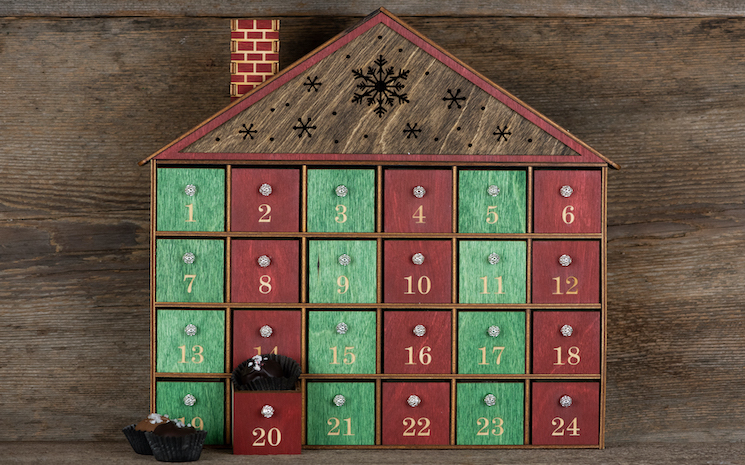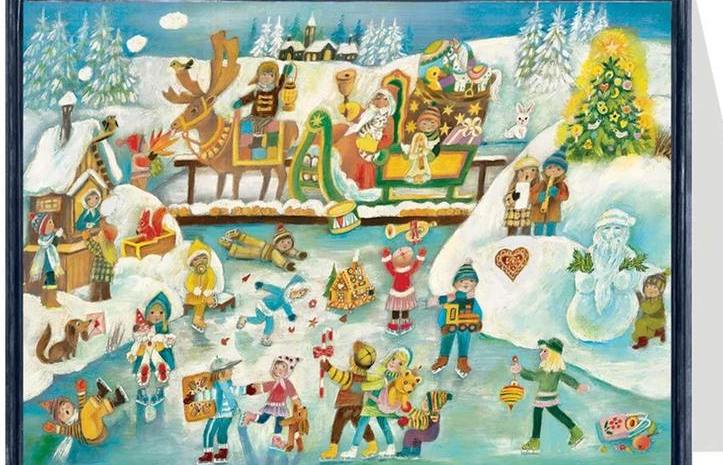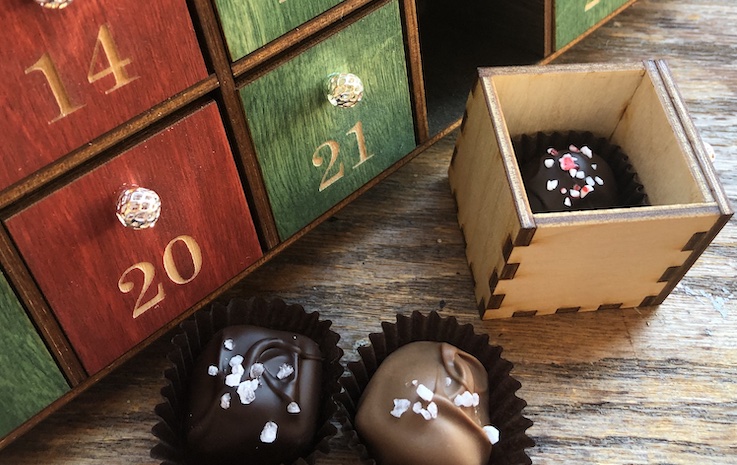
A Contemporary Chocolate Advent Calendar
A Little History, Not So Much Chocolate
Advent wasn’t always associated with little bites of chocolate hidden behind paper windows or inside cute fabric pockets. Advent itself has been observed since the 4th century, celebrating the weeks leading up to the anniversary of the birth of Christ. Historically, Christians marked their doors with chalk, wiping away a line each day, or lit candles to keep track of the days and nights until the arrival of Christmas.

Advent calendars date back only to the mid-19th century, created first by Lutherans in Germany. Traditionally, the calendar counts down the days from the Sunday closest to the feast day of St. Andrew the Apostle (November 30) and continues through the subsequent three Sundays. At the turn of the century, newspapers published Advent calendars as a gift to their readers. The British magazine Country Life printed an Advent calendar on their November cover which you can still find today.
Advent Calendars Find a Market
German-born Gerhard Lang in the early 20th century was the first to make the printed Advent calendar a commercial success, creating a predecessor of what we know today. Lang had received small cookies, one a day, sewn into the lid of a box by his mother to count the days before Christmas. He cherished this childhood custom and created his own version, with cut out pictures, poems, and prayers starting in 1908. The idea and practice spread throughout German-speaking countries and Scandinavia quickly, though was sadly interrupted by World War II, when cardboard was restricted and became unavailable for non-war use.

But in 1945, when Europe emerged from the war, the public was eager to reintroduce Christian symbols, values, and honored traditions. Richard Sellmer, whose family still creates and publishes Advent calendars on the same street – Schmellbachstrasse – in Stuttgart, Germany, revived the Advent calendar and quickly found a welcoming market internationally, especially in England and the US. The Sellmer Advent calendar is the one most of us recognize today as the quintessential holiday tradition, 24 little windows opening up to cozy Christmas scenes.
The Advent of Chocolate in the Advent Calendar
The introduction of chocolate to the Advent calendar was first created in 1958, perhaps by Sellmer, though that is less clear. Leave it to Cadbury, though, to really bring it home and popularize the chocolate Advent calendar, which they did in 1971 and are still making today. I don’t mind saying that a good Dairy Milk Cadbury Santa is always welcome where I live.
Oh, What Fun it Is!
These days, you can find just about anything behind those little windows, or even more creatively, inside boxes, doors, and drawers. Coffee, gin, socks, cheese, lipstick, nail polish, and even pork crackling can all be found in Advent calendar format. Or how about jam and honey? Dried meat? Or crocheted tchotchkes? There are 24 days of jewelry and 24 nights of romance. The NFL has an Advent calendar, as does Angry Birds. Legos too. There are eight-day Hanukkah calendars (including one with cats), which historically is celebrating something altogether different, but why not, including one with cats?

The Dean’s Sweets Holiday House Advent Calendar is like none of the above. Made by our friends at Dole’s Orchard in Limington, Maine, each little drawer can hold a truffle, caramel, buttercream, or any of our bite-sized holiday chocolate confections. The heirloom wooden calendar can be brought out year after year and will start or continue a tradition that will be cherished for many holidays to come. Fill up those little drawers with our chocolate or come up with your own hidden treasures. You too can crotchet tchotchkes or drop in a diamond ring. Our fav, after chocolate, of course, is to fill each little drawer with our kitties’ new toys and treats. In our house, the animals get all the good stuff anyway. How about in yours?